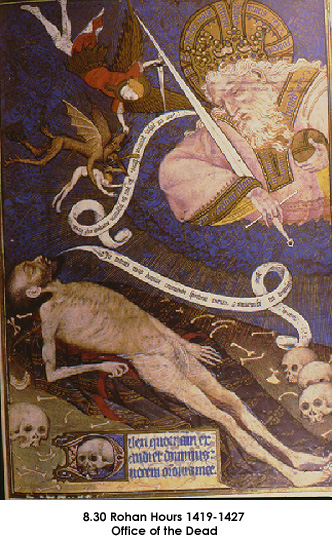The Final Things
Slide 1: Crucifixion and Entombment, Book of Hours of Jeanne d’Evreux (NY, The Met)
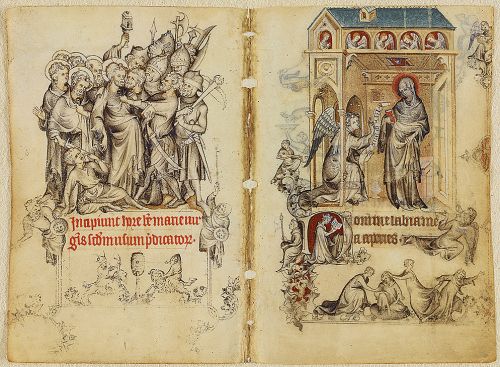
The Hours of Jeanne d’Evreux,ca. 1324-1328, Jean Pucelle (French, active in Paris, ca.1320-1334), French; made in Paris, grisaille and tempera on vellum; 3 1/2 x2 7/16 in. (8.9 x 6.2 cm), The Cloisters Collection, 1954
Slide 2: Office of the Dead, Rohan Hours (Paris, Bibi. Nat.)
Slide 3: Amiens Cathedral, Last Judgement portal

Slide 4: Jean de Berry enters Heaven, Grandes Heures de duc de Berry (Paris, Bibi. Nat.)(image not found)
Slide 5: The Three Living and the Three Dead, F. Traini, Pisa Camposanto

Slide 6: The Funeral service, Boucicaut Hours(image not found)
Slide 7: Purgatory, Trés Riches Heures (Chantilly)

Royal death and burial
Slide 8: Death of Edward the Confessor, Bayeux Tapestry
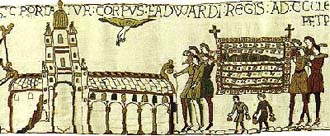
Slide 9: Funeral of Charles VII, Chronicle of Charles VII (Paris, Bib. Nat.)(image not found)
Slide 10: Capetian royal tombs, Paris, St Denis

Slide 11: Angevin Tombs, Fontevrault

Slide 12: Plantagenet tombs, Westminster Abbey
Tomb Images of Plantagenets
Slide 13: Edward II tomb, Gloucester Cathedral

Slide 14: Premysld/Luxembourg tombs, Prague Cathedral(image not found)
Episcopal tombs
Slide 15: Archbishop Peter von Aspelt, Mainz Cathedral
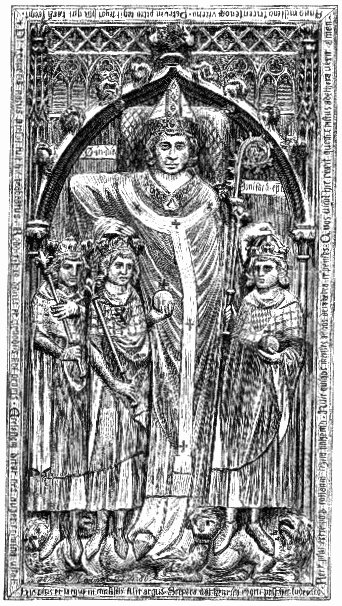
Slide 16: Bishops Eliwinus and Levericus, Wells Cathedral(image not found)
Slide 17: Archbishop Walter de Gray, York Minster
Slide 18: Bishop Giles de Bridport, Salisbury Cathedral
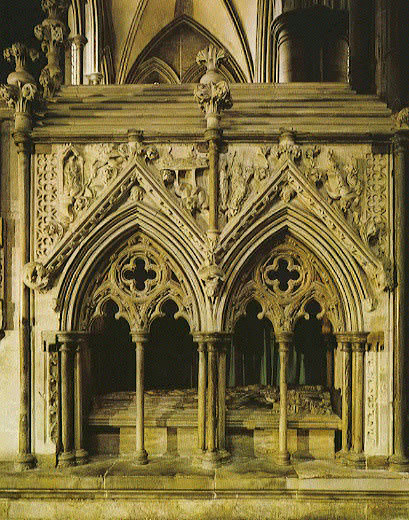
Knights and aristocracy
Slide 19: London, Temple church

ENGLAND: LONDON: The Temple Church
- Consecrated in 1185 – round shape (standard for Templar churches of this period, probably referred to the shape of the Holy Sepulcher Church in Jerusalem, where the Templars were founded). Extensive use of dark “Purbeck marble” in interior.
- Nave is 59 feet in diameter
- New, enlarged chancel consecrated in 1240. Height to Vault 36 feet 3 inches (Aisles are the same height as the central space.)
- Extensively restored in the 19th Century.
- Greatly damaged during the Second World War, and rebuilt afterwards
- Famous for its marble tomb effigies, most of which were seriously damaged during the Second World War and are now restored. (effigies in Nave, 6 of them made of Purbeck Marble)
- Purbeck Marble effigy of a Knight, ca 1245 Note Crossed Legs (Photo from 1912- before effigies were damaged in WWII)
Slide 20: Dorchester Abbey

Slide 21: Hugh Libergier, Reims Cathedral (formerly at St Nicaise)

Reims, Cathedral Notre-Dame; France, reims; 1211-end of 13c, tombstone of an architect, note set square, measuring stick, compasses and he is holding a building (unusually as this is normally done by the patron).
Multiple burials
Slide 22: Eleanor of Castile, Westminster Abbey
Eleanor of Castile (born about 1244, died 1290) has a fine tomb in St Edward’s chapel, with a gilt bronze effigy, cast by goldsmith William Torel in 1291. She died at Harby in Nottinghamshire and Edward erected memorial crosses at the places where her funeral procession rested on its way to London. She holds the string of her cloak in one hand but the sceptre in her other hand has now gone. The tomb slab and pillows beneath her head are covered with the emblems of Castile and Leon (castles and lions). On the ambulatory side is a carved iron grille of exquisite workmanship by Thomas of Leighton Buzzard. The Norman-French inscription can be translated as,
‘Here lies Eleanor, sometime Queen of England, wife of King Edward son of King Henry, and daughter of the King of Spain and Countess of Ponthieu, on whose soul God in His pity have mercy. Amen’.
Slide 23: Thibaut V, Count of Champagne, Provins(image not found)
Tomb types
Slide 24: Edmund Crouchback, Westminster Abbey
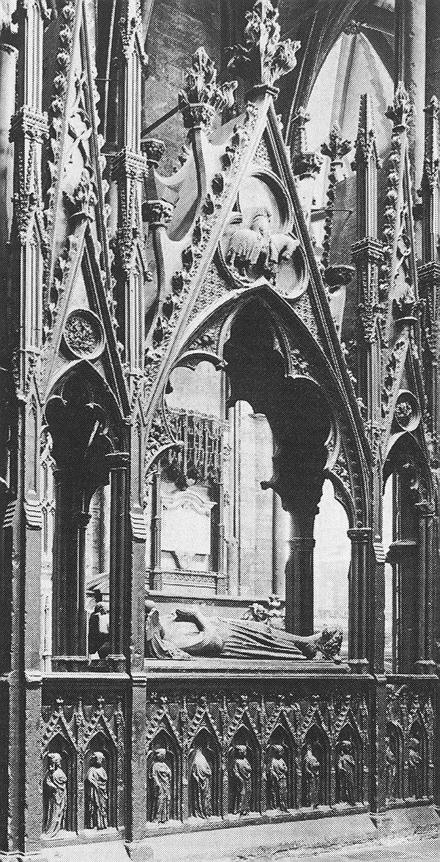
Tomb of Edmund “Crouchback”, 1296-1300, stone, Westminster Abbey, London
In England, like in France in the same period, much of the most individual sculptural work went into private family enterprises like tombs. The English royal family commissioned some splendid tombs, many of which still survive in Westminster Abbey. That of Edmund Crouchback (died 1296) survives virtually intact. It has a large canopy, and, like other contemporary French monuments, the sides are ornamented with family “weepers”.
Slide 25: Aymer de Valence and Aveline Forz, Westminster Abbey(image not found)
Slide 26: Bishop Aquablanca, Hereford Cathedral(image not found)
Slide 27: Percy Tomb, Beverly Minster

Tomb of one of the Percy’s wifes, either Lady Eleanor Percy, wife of the First Lord Percy,
or Lady Idonea Percy Wife if the second Lord Percy (d 1365)
Slide 28: Bishop Evrard de Fouilloy, Amiens Cathedral
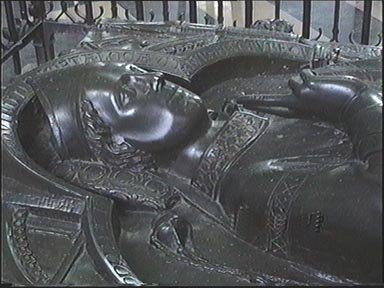
Effigy of Evrard de Fouilloy, 1st bishop builders. The effigy of Evrard de Fouilloy, cast out of bronze in only one part.
Slide 29: Richard II and Ann of Bohemia, Westminster Abbey
Monarchs Buried at Westminster Abbey
Richard II (1367-1400)
Richard was born at Bordeaux in France in 1367, the son of Edward the ‘Black Prince’ (eldest son of King Edward III) and Joan, called the ‘Fair Maid of Kent’. His father died in 1376 and so Richard succeeded his grandfather as king, being crowned in the Abbey on 16 July 1377 aged only 10. He married Anne daughter of the Emperor Charles IV of Bohemia in January 1382 and she was crowned two days later. A contemporary portrait of the King wearing coronation robes seated in the Coronation Chair and holding the orb and sceptre still hangs in the nave of the Abbey. This wooden panel-painting is the earliest known portrait of an English monarch, dating from the 1390s. The suggestion has been made that the artist was court painter André Beauneveu. The vivid colours show the king in a green tunic decorated with the letter R, wearing a crimson robe lined with ermine, an ermine cape, vermilion socks and gold shoes. It was restored and re-framed in the 19th century.
Richard was devoted to the Abbey and to St Edward the Confessor and he rebuilt the northern entrance and some bays of the nave. He also partly rebuilt Westminster Hall, in the Palace of Westminster. His wife Anne died in 1394 and he was so grief stricken that he demolished Sheen Palace, where she had died. Although a handsome, cultured man he was not a successful ruler and he was deposed as king and imprisoned in 1399 by his cousin Henry Bolingbroke (who became Henry IV), son of John of Gaunt, Duke of Lancaster. He died in Pontefract Castle on or about 14 February 1400, most probably from starvation. However, rumours spread that he was actually murdered so his body was brought for public view to St Paul’s in London and then was buried at a friary in Langley, Hertfordshire. When Henry V came to the throne he ordered the removal of the body to Westminster Abbey in 1413 to join Anne in the tomb Richard had erected for them in the chapel of St Edward the Confessor, next to that of Edward III. The tomb was made in 1396-9 by London masons Henry Yevele and Stephen Lote, and coppersmiths Nicholas Broker and Godfrey Prest cast the gilt bronze effigies. Richard and Anne were originally depicted holding hands, but they have been broken off. The effigies are stamped all over with patterns and Plantagenet badges – the broompod, white hart and sun-burst on the king’s figure and knots, crowned initials A and R and chained ostriches on Anne’s effigy….
Slide 30: Wooden effigy of a knight, Southwark Cathedral
This is one of only 94 similar wooden effigies in Great Britain. The knight wears mail coat and coif dating him to around 1280. The carving is very similar to stone effigies of the same period. The effigy has been located in many different places and repaired on several occasions.
It is often stated that the legs being crossed at the ankles means that the knight was a crusader, however there is no evidence to support this. The identity of the knight is unknown but it is thought he was may be a member of the de Warenne family which had strong links with the church at this time.
Slide 31: Brasses, Stoke D’Abernon (Cobham)

Sir John d’Abernon II, 1327, Stoke d’Abernon, Surrey
Enclosed tombs, chantries and other forms of commemoration
Slide 32: Pope John XXII, N.D. des Doms, Avignon(image not found)
Slide 33: Clement VI, La Chaise Dieu(image not found)
Slide 34: Wykeham chantry, Winchester Cathedral

Slide 35: Wayneflete chantry, Winchester Cathedral

Slide 36: Ekkehard and Uta, Naumburg Cathedral
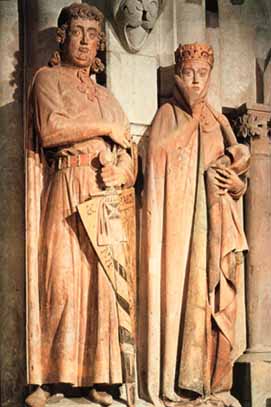
Slide 37: Geddington Cross

(compare with Meeting of the Magi, Trés Riches heures)
Slide 38: Hardingston Cross
Stone Crosses of Northampton The Cross erected in memory of Queen ELEANOR, near Northampton.
Slide 39: Equestrian Statue of Phillipe le Bel, formerly at Paris, Notre Dame(image not found)
Slide 40: Merton College Chapel(image not found)

